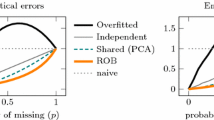Abstract
In wireless sensor networks, the missing of sensor data is inevitable due to the inherent characteristic of wireless sensor networks, and it causes many difficulties in various applications. To solve the problem, the missing data should be estimated as accurately as possible. In this paper, an adaptive missing data estimation algorithm is proposed based on the spatial correlation of sensor data. It adopts multiple regression model to estimate the missing data with the data of multiple neighbor nodes jointly rather than independently, which makes its estimation performance stable and reliable. In addition, for different missing data, it can adjust the estimation equation adaptively to capture the dynamic correlation of sensor data. Thereby, it can estimate the missing data more accurately. Further more, it can also give the confidence interval of each missing data for the given confidence level, which is helpful greatly for users. Experimental results on two real-world datasets show that the proposed algorithm can estimate the missing data accurately.






Similar content being viewed by others
References
D. J. Abadi, S. Madden, and W. Lindner, Reed: robust, efficient filtering and event detection in sensor networks. In: VLDB, pp. 769–780 (2005).
D. Chu, A. Deshpande, J. M. Hellerstein, and W. Hong, Approximate data collection in sensor networks using probabilistic models. In: ICDE, p. 48 (2006).
J. Considine, F. Li, G. Kollios, and J. W. Byers, Approximate aggregation techniques for sensor databases. In: ICDE, pp. 449–460 (2004).
Culler, D.E., Estrin, D., Srivastava, M.B.: Guest editors’ introduction: Overview of sensor networks. IEEE Computer 37(8), 41–49 (2004)
A. Deshpande, C. Guestrin, W. Hong, and S. Madden, Exploiting correlated attributes in acquisitional query processing. In: ICDE, pp. 143–154 (2005).
A. Deshpande, C. Guestrin, S. Madden, J. M. Hellerstein, and W. Hong, Model-driven data acquisition in sensor networks. In: VLDB, pp. 588–599 (2004).
W. F. Fung, D. Sun, and J. Gehrke, Cougar: the network is the database. In: SIGMOD Conference, p. 621 (2002).
L. Gruenwald, H. Yang, M. S. Sadik, and R. Shukla, Using data mining to handle missing data in multi-hop sensor network applications. In: MobiDE, pp. 9–16 (2010).
M. Halatchev, and L. Gruenwald, Estimating missing values in related sensor data streams. In: COMAD, pp. 83–94 (2005).
N. Jiang, and L. Gruenwald, Estimating missing data in data streams. In: DASFAA, pp. 981–987 (2007).
Y. Li, C. Ai, W. P. Deshmukh, Y. Wu, Data estimation in sensor networks using physical and statistical methodologies. In: ICDCS, pp. 538–545 (2008).
S. Madden, Intel berkeley research lab data. http://berkeley.intel-research.net/labdata/ (2003).
S. Madden, M. J. Franklin, J. M. Hellerstein, and W. Hong, The design of an acquisitional query processor for sensor networks. In: SIGMOD Conference, pp. 491–502 (2003).
A. Manjhi, S. Nath, and P. B. Gibbons, Tributaries and deltas: efficient and robust aggregation in sensor network streams. In: SIGMOD Conference, pp. 287–298 (2005).
A. Silberstein, R. Braynard, C. S. Ellis, K. Munagala, and J. Yang, A sampling-based approach to optimizing top-k queries in sensor networks. In: ICDE, p. 68 (2006).
A. Silberstein, K. Munagala, and J. Yang, Energy-efficient monitoring of extreme values in sensor networks. In: SIGMOD Conference, pp. 169–180 (2006).
G. Tolle, Sonoma redwooods data. http://www.cs.berkeley.edu/ get/sonoma/ (2005).
X. Yang, H. B. Lim, M. T. Özsu, and K. L. Tan, In-network execution of monitoring queries in sensor networks. In: SIGMOD Conference, pp. 521–532 (2007).
Yao, Y., Gehrke, J.: The cougar approach to in-network query processing in sensor networks. SIGMOD Record 31(3), 9–18 (2002)
H. Zhang, J. M. F. Moura, and B. H. Krogh, Estimation in sensor networks: a graph approach. In: IPSN, pp. 203–209 (2005).
Acknowledgments
This work was supported in part by the National Grand Fundamental Research 973 Program of China (Grant No. 2012CB316202), the Major Program of National Natural Science Foundation of China (Grant No. 61190115), the National Natural Science Foundation of China (Grant No. 61133002, 61100030), the China Postdoctoral Science Foundation (Grant No. 20110491060), the Fundamental Research Funds for the Central Universities (Grant No. HIT.NSRIF.201179), the Natural Science Foundation of Heilongjiang Province (Grant No. F201430), the Open Foundation of Key Laboratory of Database and Parallel Computing in Heilongjiang Province (Grant No. KLDP-OF-2012-10), the Scientific Research Fund of Heilongjiang Provincial Education Department (Grant No. 12531476), the Young Innovative Talents Research Foundation of Harbin Science and Technology Bureau (Grant No. 2012RFQXG096).
Author information
Authors and Affiliations
Corresponding author
Rights and permissions
About this article
Cite this article
Pan, L., Gao, H., Gao, H. et al. A Spatial Correlation Based Adaptive Missing Data Estimation Algorithm in Wireless Sensor Networks. Int J Wireless Inf Networks 21, 280–289 (2014). https://doi.org/10.1007/s10776-014-0253-9
Received:
Accepted:
Published:
Issue Date:
DOI: https://doi.org/10.1007/s10776-014-0253-9




